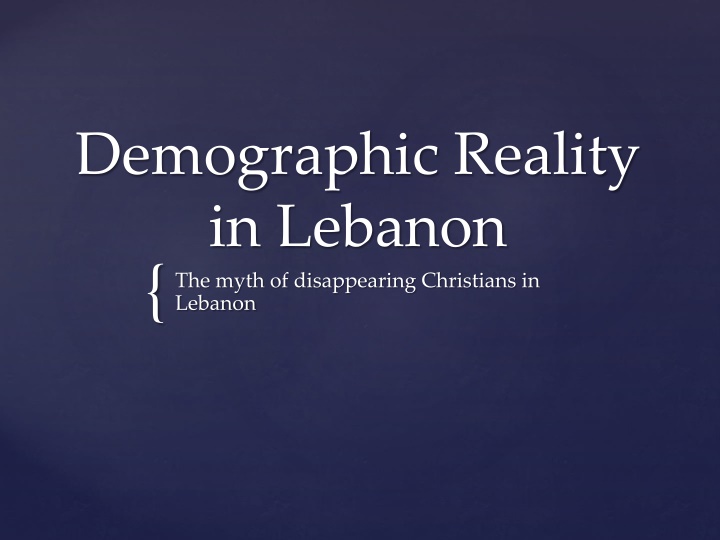
Demographic Reality in Lebanon: The Truth About Christians
Discover the demographic changes in Lebanon over the years, focusing on the Christian population that has been a prominent aspect of Lebanese society. Explore the historical census data, emigration trends, and factors affecting fertility rates that have influenced the country's population dynamics.
Download Presentation

Please find below an Image/Link to download the presentation.
The content on the website is provided AS IS for your information and personal use only. It may not be sold, licensed, or shared on other websites without obtaining consent from the author. If you encounter any issues during the download, it is possible that the publisher has removed the file from their server.
You are allowed to download the files provided on this website for personal or commercial use, subject to the condition that they are used lawfully. All files are the property of their respective owners.
The content on the website is provided AS IS for your information and personal use only. It may not be sold, licensed, or shared on other websites without obtaining consent from the author.
E N D
Presentation Transcript
Demographic Reality in Lebanon The myth of disappearing Christians in Lebanon {
The last official census in Lebanon which was conducted in 1932 indicated that the population was 875,252 with around 53% as Christians. Other censuses were conducted unofficially; for example in 1956 it was estimated that the population was 1,411,416, with around 54% Christians and 44% Muslims. According to recent statistics done by the CIA fact-book, the Christians constitute around 39% of the population and Muslims constitute around 59.7%. Conducting a census has been a very sensitive issue due to the sectarian divisions in the country and due to the pressure that some groups could practice in case statistics showed a wide shift in the population demographics.
For more than a century and a half, Lebanon has been characterized by high emigration flux due to the economic and the political situation. This reality is due to Lebanon s geographic location in addition to other internal and external conflicts.
1975-2011 Percentage Christians 46.64% Muslims 53.36 Recent Emigration
7 6 5 4 3 2 197 1 1 0 Other Christian s Maronite s Shiites Sunnites Druzes Lebanon 1971 6.65 5.2 3.55 3.75 3.35 5 2004 2.1 1.76 1.5 1.61 1.45 1.75 Fertility Rates 1971/2004
6 5 4 3 1971 2 2004 1 0 Muslims Christians 1971 2004 5.44 1.82 3.56 1.53
Higher literacy rate for boys and in later stages for girls increased their ability to read and write at their early twenties. The advance in education delayed the age of marriage. The advance in education contributed in the use of contraception devices, especially by women. Significant decrease of marriage between cousins and relatives, which resulted in lowering the family rigidity and the closure of social groups. Urbanization The internal displacement into cities and suburbs which requires a different mode of life of that than in the villages. Decrease in fertility rate allowed parents to focus more on each child, especially on the education level. The direct effect of globalization. Factors Affecting Fertility
General Population Global Christians Muslims 2011 2,981,015 34.35% 65.47% 2030 4,133,015 37.55% 62.32% 2045 5,033,015 39.03% 60.86% Projections
